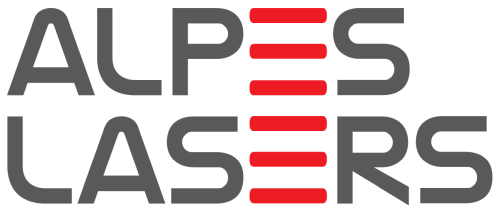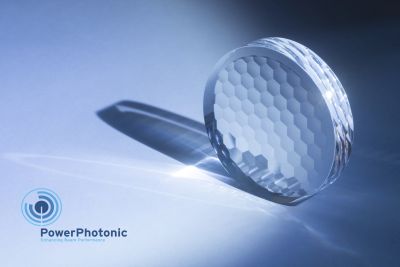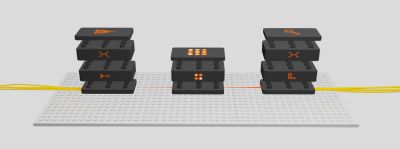beam combining (original) (raw)
Definition: a class of techniques for power scaling of laser sources by combining the outputs of multiple devices
Categories:  laser devices and laser physics,
laser devices and laser physics,  methods
methods
Related: coherent beam combiningspectral beam combiningpower scaling of lasershigh-power lasershigh-power fiber lasers and amplifierscoherence
Page views in 12 months: 2581
DOI: 10.61835/bob Cite the article: BibTex BibLaTex plain textHTML Link to this page! LinkedIn
Content quality and neutrality are maintained according to our editorial policy.
📦 For purchasing beam combining optics, use the RP Photonics Buyer's Guide — an expert-curated directory for finding all relevant suppliers, which also offers advanced purchasing assistance.
Contents
Principles of Beam Combining
Various laser architectures allow the development of high-power laser sources with high beam quality, i.e., high radiance (brightness). However, all of these approaches have their limitations, and some envisaged laser applications would require a higher laser power and brightness (radiance) than appears to be feasible with any known laser technology. Another problem is that very high-power laser systems are developed and built only in small numbers, making the devices fairly expensive.
A viable solution to these challenges could be the principle of beam combining, which essentially means combining the outputs of multiple laser sources (often in the form of laser arrays) so as to obtain a single output beam. The use of a scalable beam-combining technology leads to a power-scalable laser source, even if the single lasers are not scalable.
The goal of beam combining is generally not only to multiply the output optical power, but also to preserve the beam quality, so that the radiance is increased (nearly) as much as the output power. Therefore, it is generally not sufficient, e.g., to combine mutually incoherent beams side by side because this would increase the beam area while not decreasing the beam divergence, consequently increasing the beam parameter product and reducing the beam quality.
There are many different approaches for beam combining with increased brightness, but these can all be grouped into one of two categories:
- Coherent beam combining works with beams which are mutually coherent. Coherent polarization beam combining is one variant; other techniques are side-by-side combining and filled-aperture combining. In the conceptually simplest case, monochromatic beams with the same optical frequency are combined. However, some schemes of coherent beam combination work with emission on multiple frequencies, with the emission spectra of all emitters being the same. That technique can also be applied to broadband ultrashort pulses.
- Spectral beam combining (also called wavelength beam combining or incoherent beam combining) does not require mutual coherence, but rather uses emitters with non-overlapping optical spectra. The single beams are then fed into a wavelength-sensitive beam combiner, such as a prism, a diffraction grating, a dichroic mirror, or a volume Bragg grating.
These techniques are discussed in more detail in the corresponding articles. They can be applied to various laser sources, e.g., based on laser diodes (particularly diode bars) and fiber amplifiers, but also to high-power solid-state bulk lasers and VECSELs.
Comparison of Coherent and Spectral Beam Combining
Coherent and spectral beam combining techniques are substantially different in various respects:
- Spectral beam combining has the great advantage of not requiring mutual temporal coherence of the combined beams. This eliminates some important technical challenges and makes it much easier to obtain stable operation at high power levels. It may also be beneficial that a stable polarization is not required in principle, although e.g. the use of diffraction gratings often reintroduces this requirement.
- If fiber amplifiers are used, the requirement of single-frequency operation, which is associated with some techniques of coherent combining, makes it more difficult to reach high power levels because it favors nonlinear optical effects such as stimulated Brillouin scattering.
- Spectral beam combining inevitably generates output beams with several (or many) spectral components, thus spanning a significant optical bandwidth. This means that the spectral brightness is smaller than that of the single emitters. This does not matter for some applications while excluding others, where a narrow-bandwidth output is required.
- At least compared with tiled-aperture techniques of coherent beam combining, spectral beam combining makes it easier to combine the beams without any significant loss of beam quality.
- Spectral beam combining is also superior in terms of more graceful degradation because the failure of one emitter simply reduces the output power accordingly, whereas in the case of tiled-aperture coherent beam combining it also affects the output beam quality and thus reduces the output brightness even more than the power.
In conclusion, it is to be expected that methods of spectral beam combining will find more widespread application, although coherent methods will in some cases be required, e.g. due to constraints concerning the optical spectrum.
Applications of Beam Combining
Beam-combined laser systems can reach output power levels of tens to hundreds of kilowatts. Applications of such systems are often in the military sector, e.g., in the context of anti-missile and other directed energy laser weapons. There are also possibilities for long-distance free-space optical communications [1] and laser-based manufacturing.
Frequently Asked Questions
What is laser beam combining?
Laser beam combining is a technique used to merge the outputs of multiple laser sources into a single, more powerful output beam. The primary goal is to increase the total power while preserving the beam quality, thereby increasing the radiance (brightness).
What are the main types of beam combining?
The two main categories are coherent beam combining, which merges mutually coherent beams, and spectral beam combining (or wavelength beam combining), which uses emitters operating at different, non-overlapping optical wavelengths.
How does spectral beam combining work?
Spectral beam combining merges beams from multiple emitters that operate at different wavelengths. A wavelength-sensitive optical element, such as a diffraction grating or a prism, is used to superimpose these beams into a single, multicolored output beam.
What are the advantages of spectral beam combining?
Spectral beam combining is generally simpler and more stable than coherent combining because it does not require mutual coherence and complex phase control. It also offers more graceful degradation, as the failure of a single emitter only reduces power without severely affecting beam quality.
What are typical applications of beam-combined lasers?
With output powers reaching tens or hundreds of kilowatts, beam-combined laser systems are used for demanding applications like directed energy laser weapons, long-distance free-space optical communications, and advanced laser materials processing.
Suppliers
Sponsored content: The RP Photonics Buyer's Guide contains 37 suppliers for beam combining optics. Among them:
⚙ hardware
Our wavelength beam combiner (splitter) is a micro-optics based fiber wavelength beam combiner (splitter) with any wavelength range from 300 nm — 2400 nm. Specifically, the OEWBC-100 can combine or split two or more wavelengths in the range 300 nm — 2400 nm. It can work with single-mode fiber, multimode fiber, PM fiber and plastic-optical fiber. Virtually any number of input wavelengths can be combined with high efficiency and low insertion loss.
⚙ hardware
OPTOMAN offers laser beam combining optics with durable sputtered coatings optimized for laser line or broadband performance, s-pol or p-pol components, ultrashort pulses or CW applications, highest LIDT, and small splitting tolerance. Steep edge dichroic mirrors are available in efficiency-optimized configurations (transmittance >99% or reflectance >99.9%), also featuring minimum pulse dispersion and no spectral drift.
⚙ hardware
The Alpes Lasers Beam Combiner is a platform that allows the output beam of two different quantum cascade lasers in standard HHL housing to be combined into a single beam. The system uses fixed optics to rotate the polarization of one of the beam and combines them using a polarizing plate, resulting in a combined beam with the combined power of both original beams. The platform is supplied with both laser housing installed and aligned. The lasers use separate drivers (drivers and temperature controllers sold separately) and can be driven independently or concurrently.
⚙ hardware
PowerPhotonic has multiple offerings for beam combining. This can be provided through single optics or through a specially designed beam combining module. PowerPhotonic can provide high power handling, freeform optics for beam combining that provides high shaping efficiency and high power in the bucket. These beam combiners are perfectly suited for coherent beam combination and spectral beam combining.
⚙ hardware
Cailabs designs and manufactures a wide range of coherent and incoherent fiber-optic beam combiners with very high efficiency and optimal output beam quality, for a wide range of wavelength, from near-IR for direct energy weapons to mid-IR for countermeasure applications. They can be used with quantum cascade lasers, for example.
⚙ hardware
Our X-cubes enable combination of 3 beams in one or splitting of one beam in 3, most common usage is RGB display, dimensions can be custom made.
Bibliography
| [1] | G. S. Mecherle, “Laser diode combining for free space optical communication”, Proc. SPIE 616, 281 (1986); doi:10.1117/12.961064 |
|---|---|
| [2] | T. Y. Fan, “Laser beam combining for high-power, high-radiance sources”, JSTQE 11 (3), 567 (2005); doi:10.1109/JSTQE.2005.850241 (review paper) |
| [3] | Special issue on beam combining: IEEE Sel. Top. Quantum Electron. 15 (2) (2009) |
(Suggest additional literature!)
http://findarticles.com/p/articles/mi\_qa3957/is\_200601/ai\_n17180030 %%
Questions and Comments from Users
Here you can submit questions and comments. As far as they get accepted by the author, they will appear above this paragraph together with the author’s answer. The author will decide on acceptance based on certain criteria. Essentially, the issue must be of sufficiently broad interest.
Please do not enter personal data here. (See also our privacy declaration.) If you wish to receive personal feedback or consultancy from the author, please contact him, e.g. via e-mail.
By submitting the information, you give your consent to the potential publication of your inputs on our website according to our rules. (If you later retract your consent, we will delete those inputs.) As your inputs are first reviewed by the author, they may be published with some delay.










